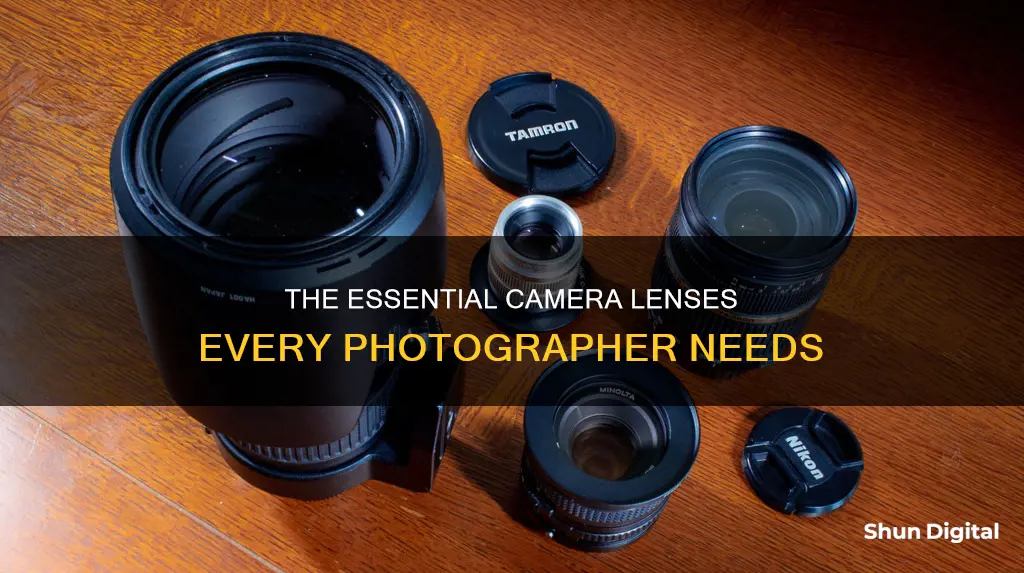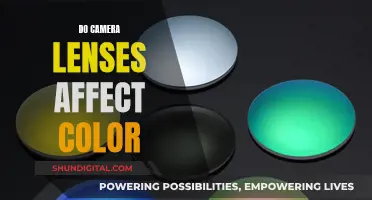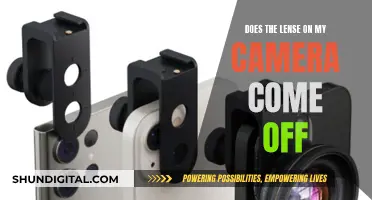
Choosing the right camera lens is essential for taking good photographs. The type of lens you need depends on what you're shooting and what you're using the lens for. There are many lenses to choose from, but some of the most important ones to have in your kit are:
- A standard zoom lens: This lens is great for everyday photography and offers a bit of everything. It typically has a focal length of around 24-70mm, allowing you to get wide angles and zoom in for crisp, detailed shots.
- A telephoto lens: This lens is perfect for capturing distant subjects like wildlife or sports. It has a focal length of 70mm and above, offering a selective angle of view.
- A wide-angle lens: This lens is ideal for capturing dramatic landscapes or tight spaces like car interiors. It has a focal length of about 10-35mm, giving you an expansive view.
- A prime lens: These lenses have a single focal length and are often smaller, lighter, and have a larger maximum aperture than zoom lenses. They're great for low-light photography and creating shallow depth-of-field effects.
- A macro lens: This lens is designed for close-up photography, allowing you to capture tiny objects like insects or jewellery in detail.
| Characteristics | Values |
|---|---|
| Lens type | Wide-angle prime, normal prime, telephoto prime, telephoto zoom, wide-angle zoom |
| Focal length | 18mm, 24mm, 35mm, 50mm, 70mm, 200mm, 200-500mm |
| Aperture | f/2, f/2.8, f/4, f/5.6, f/8, f/11, f/16, f/22 |
| Zoom range | 18-55mm, 16-35mm, 24-70mm, 24-105mm, 24-200mm, 70-200mm, 100-400mm, 150-600mm |
What You'll Learn

Wide-angle prime lenses for landscapes and group photos
Wide-angle prime lenses are ideal for landscape photography, as they allow you to capture as much of the scene as possible in a single frame. They are also useful for group photos, as they provide a broader field of view, ensuring that everyone fits into the shot.
When choosing a wide-angle prime lens for landscapes, consider the focal length, aperture, and image quality. A focal length of 14mm to 24mm will give you an ultra-wide perspective, perfect for capturing sweeping vistas. An aperture of f/1.4 to f/2.8 will allow more light to enter the lens, resulting in brighter and sharper images, even in low-light conditions. Additionally, look for lenses with high-quality optics that deliver sharp and distortion-free images.
- Sony FE 14mm f/1.8 G Master: This lens offers a unique perspective with well-controlled distortion and exceptional optical quality. It is perfect for night-time landscapes and star trails due to its wide aperture. However, it lacks a filter thread for common-sized filters.
- Sony FE 24mm f/1.4 G Master: With an aperture of f/1.4, this lens provides excellent low-light capabilities and beautiful background blur. It is versatile and lightweight, making it ideal for landscape and group photography. It also accepts traditional circular filters or square filter holders.
- Sigma 20mm f/1.4 DG HSM Art: Offering a slightly wider aperture of f/1.4 compared to the Sony FE 20mm f/1.8 G, this lens provides better low-light performance. However, it is heavier and longer, which may be a consideration if you have limited bag space. It also lacks a front filter thread due to its built-in lens hood.
- Canon EF-S 10-22mm f/3.5-4.5 USM: Designed for Canon APS-C sensor cameras, this lens provides a focal range equivalent to 16-35mm on a full-frame body. It is compact, lightweight, and delivers excellent image quality with minimal distortion. It also has a close focusing distance of 24cm, allowing you to capture stunning foreground details.
- Nikon AF-S 16-35mm f/4G ED VR: This full-frame lens offers excellent sharpness and distortion-free images thanks to its aspherical and extra-low dispersion elements. It features a nine-bladed diaphragm for softer rendering of landscape details and is weather-sealed for shooting in harsh conditions.
Switching Camera Lenses: A Step-by-Step Guide for Beginners
You may want to see also

Telephoto prime lenses for sports and wildlife photography
Telephoto prime lenses are ideal for sports and wildlife photography as they allow the photographer to capture distant subjects in incredible detail. They are also useful for portraits, as they can flatten harsh facial features.
When shooting sports or wildlife, it is likely that you will be a considerable distance from the action, so a telephoto lens with a long focal length is required to get close-up shots. The longer the focal length, the heavier and more expensive the lens will be.
For sports photography, a telephoto lens with a focal length of 300mm or more is ideal. The Nikon NIKKOR Z 400mm f/2.8 TC VR S Lens, for example, is a great choice for sports photography as it has a fast autofocus system and advanced optical VR stabilisation.
For wildlife photography, a super-telephoto lens with a focal length of 500mm or more will allow you to get close-up shots of animals without disturbing them. The Sigma 500mm F4 DG OS HSM | S lens is a great choice for wildlife photography as it has a fast and accurate autofocus system and a wide maximum aperture.
It is important to note that the longer the focal length, the narrower the maximum aperture will be. This can be an issue when shooting in low-light conditions, so it is important to consider the type of photography you will be doing before choosing a telephoto prime lens.
In addition to the focal length and maximum aperture, other factors to consider when choosing a telephoto prime lens for sports and wildlife photography include the weight of the lens, the image stabilisation system, and the autofocus system. It is also important to ensure that the lens is compatible with your camera mount.
The Ultimate Guide to Storing Your Camera and Lenses
You may want to see also

Standard zoom lenses for everyday photography
A standard zoom lens is a must-have for any photographer, whether a beginner or a professional. It is the perfect all-rounder, offering a bit of everything and allowing you to shoot in almost any situation.
Standard zoom lenses typically have a focal length range of around 18mm to 70mm, or 24mm to 70mm, giving you the flexibility to capture both wide-angle and telephoto shots. At the wide end, you benefit from an expansive field of view, perfect for environmental shots, landscapes, and street photography. On the other hand, the longer end of the focal range provides a field of view similar to that of the human eye, making it suitable for portraits and tighter shots.
These lenses are highly versatile and come in various shapes and sizes. You can opt for an 18-55mm kit lens, which is often included with entry-level cameras, or invest in a more expensive 24-70mm lens. The latter usually offers a wider maximum aperture, such as f/2.8, which is ideal for low-light shooting and precise depth-of-field control.
Some popular options for standard zoom lenses include:
- Canon EF-S 18-55mm f/4-5.6 IS STM
- Canon EF 24-70mm f/4L IS
- Nikon AF-S DX 18-55mm f/3.5-5.6G II
- Sony 24-70mm f/2.8 GM
While standard zoom lenses are incredibly useful, they may not be the best choice for certain specialised types of photography, such as wildlife or sports photography, where you would typically require longer focal lengths to capture distant subjects.
However, for everyday photography, a standard zoom lens is an excellent tool to have in your kit, providing the versatility and flexibility to capture a wide range of subjects and scenes.
Choosing Camera Lenses: A Guide to Shopping for Beginners
You may want to see also

Macro lenses for close-up photography
Macro lenses are designed to focus at extremely short distances, allowing photographers to capture tiny subjects in extreme detail. They are an essential tool for anyone looking to capture the world in miniature, from wildlife and nature photographers to product and portrait photographers.
When choosing a macro lens, the most important factor to consider is the magnification ratio. A "true" macro lens will have a ratio of at least 1:1, meaning that the subject will appear on the camera's sensor at the same size or larger than its real-world size. Some macro lenses offer even higher magnification ratios, such as 2:1 or 5:1, allowing for even greater detail to be captured.
Another key feature of macro lenses is their ability to focus at very short distances. This enables photographers to get extremely close to their subjects, often just a few inches away. This is essential for capturing small subjects and can also be useful for handheld shooting, as it allows for slower shutter speeds without the need for a tripod.
In addition to magnification and focusing distance, other factors to consider when choosing a macro lens include focal length, aperture, autofocus capabilities, and image stabilization.
Focal length will determine how close you need to be to your subject, with shorter focal lengths requiring you to get closer. A focal length of at least 100mm is generally recommended, as it provides a good balance between working distance and magnification.
While many macro lenses have apertures of f/2.8 or f/4, it's important to note that narrower apertures are often preferred in macro photography to increase depth of field. However, wider apertures can still be useful for portrait photography, as they can create beautiful bokeh and creamy backgrounds.
Some macro lenses also offer autofocus and image stabilization, which can be useful for handheld shooting or when capturing moving subjects.
- Canon RF 100mm f/2.8L Macro IS USM: This lens offers a magnification ratio of 1.4:1, highly effective stabilisation, and a dedicated bokeh control ring.
- Nikon Z MC 105mm f/2.8 VR S: This lens offers a practical focal length for macro photography, superb image quality, and highly effective optical stabilisation.
- Fujifilm XF 80mm f2.8 LM OIS WR Macro: This lens provides gorgeous image quality, a maximum aperture of f/2.8 for depth-of-field flexibility, and extensive weatherproofing.
- Sony FE 90mm f/2.8 Macro G OSS: This lens is packed with features, including rapid and silent autofocus, optical stabilisation, and a precision-engineered metal casing.
- OM System M.Zuiko 90mm f/3.5 Macro: With a magnification ratio of 2:1, this lens delivers an equivalent 4:1 reproduction ratio, resulting in an incredibly detailed image.
- Panasonic Lumix S 100mm f/2.8 Macro: This lens stands out for its compact size and weight, particularly notable for a full-frame macro lens. It also offers sharp image quality and accurate focusing.
These are just a few examples of the many excellent macro lenses available on the market. When choosing a macro lens, it's important to consider your specific needs and budget, as well as the camera system you are using.
Calibrating Camera Lenses: The Ultimate Guide to Perfection
You may want to see also

Portrait lenses for flattering, shallow depth-of-field shots
Portrait lenses are used to create flattering, shallow depth-of-field shots. They are available in both zoom and prime types. Zoom lenses are versatile and have variable focal lengths, while prime lenses have large maximum apertures, few structural complications, and are a top choice for many portrait photographers.
The 50mm lens is one of the best lens sizes for portraits. Portrait photographers praise 50mm lenses for their versatility. The 50mm field of view is great for portrait photography, giving enough subject separation to allow your subject to stand out from their background.
The Canon EF 50mm f/1.2L USM lens has an extremely large aperture. The Canon 50mm f/1.2L is nearly unrivalled in its price range for its narrow depth of field detail.
The Nikon AF-S NIKKOR 50mm f/1.8G lens is another great option for capturing light and delivering a natural depth of field.
The 85mm lens is another popular choice for portrait photography. It provides a flattering compressed look to the subject while retaining the personal feel of a wider lens.
The Canon EF 85mm f/1.2L II is a great choice for portrait photography, providing a flattering perspective while allowing some space between the photographer and the subject.
The Nikon AF-S NIKKOR 85mm f/1.8G is a great budget option, offering a fast maximum aperture and good bokeh at wider apertures.
The 35mm lens is typically the widest lens used for portrait photography. It provides a big field of view, allowing for unique compositions. The Canon 35mm f/1.4L USM wide-angle lens consistently ranks as one of the best 35mm lenses on the market and is a good choice for portrait photography.
Best Budget Camera Lenses: Enhance Photography Under $200
You may want to see also
Frequently asked questions
The classic choice for a beginner is a 50mm prime lens, which is versatile, affordable, lightweight, bright, and optically excellent. Alternatively, a wide-to-telephoto zoom lens like a 24-105mm or 28-200mm will cover the most important focal lengths in one package.
For a more advanced photographer, a telephoto zoom lens like a 70-200mm f/2.8 or 80-200mm f/2.8 is a good choice. A wide-angle prime lens (24mm, 28mm, or 35mm) is also useful for travel photography and taking group photos.
Depending on your specific needs, other important lenses to consider include a macro lens for close-up photography, a portrait lens (e.g. 85mm f/1.8) for flattering portraits, and a wide-angle zoom lens (e.g. 10-24mm or 16-35mm) for landscape photography.







